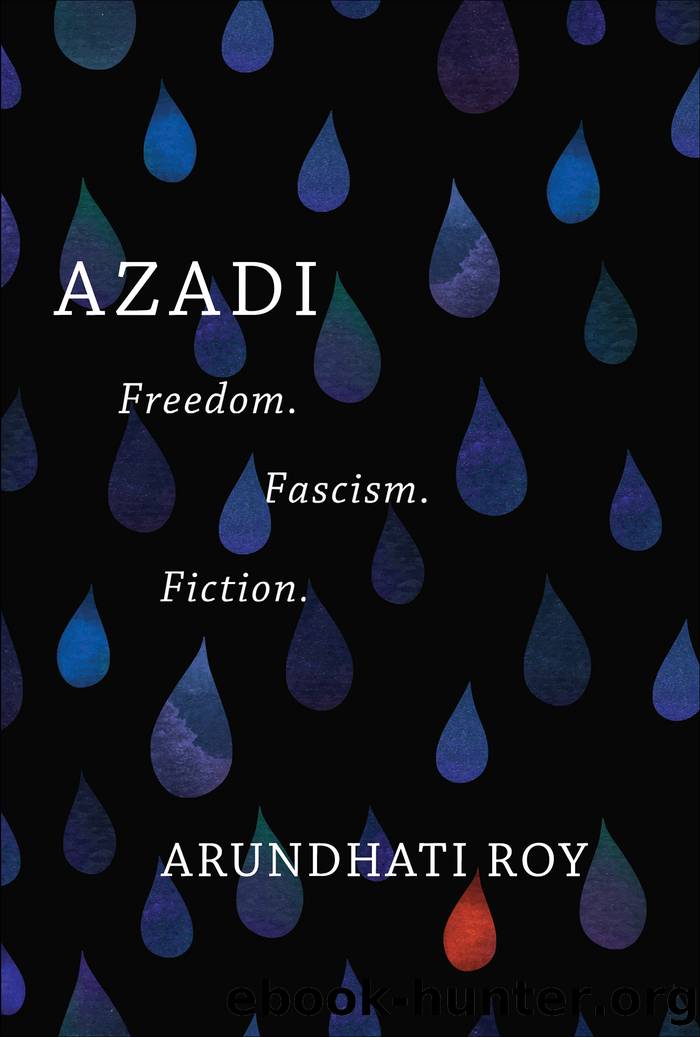AZADI: Freedom. Fascism. Fiction. by Arundhati Roy

Author:Arundhati Roy [Roy, Arundhati]
Language: eng
Format: epub
ISBN: 9781642592603
Google: kDZHzQEACAAJ
Amazon: 1642592609
Publisher: Penguin
Published: 2020-08-14T16:00:00+00:00
* The Jonathan Schell Memorial Lecture Series on the Fate of the Earth, delivered at Cooper Union Great Hall, New York, November 19, 2019. First published in The Nation, November 22, 2019.
CHAPTER SEVEN
The Graveyard Talks Back
Fiction in the Time of Fake News
Thank you for inviting me to deliver this, the Clark Lecture, now in its 132nd year. When I received the invitation, I scrolled down the list of previous speakers, the many âSirsâ and Sir-sounding names who have spoken on topics as varied as âLiterary Criticism of the Age of Queen Anne,â âShakespeare as Criticised in France from the Time of Voltaire,â âThe Crowning Privilege: Professional Standards in English Poetryâ and âMakers and Materials: The Poetry of Spenser, Shakespeare, Milton, Yeats, and Eliot.â In the cartoon version of this story, at this point the character playing me would furrow her brow and her speech balloon would say, âHuh?â I was reassured when my eye fell on âStudies in American Africanismâ by Toni Morrison, but only momentarily. I asked Dr. John Marenbon, who invited me, if I could look at the texts of some previous lectures, since I couldnât find them on the internet. He most helpfully replied that speakers were never asked to deposit their lectures with Trinity, but that T. S. Eliotâs The Varieties of Metaphysical Poetry had evolved from his Clark lecture, as had E. M. Forsterâs Aspects of the Novel.
In other wordsâno pressure.
This lecture has evolved from a series of recent talks I have given about the place for literature in the times in which we live, and about the politics of language, both public and private. This makes my task a little slippery. It might occasionally involve the presumption that many of you are familiar with my work, which may not be the case and for which I apologize.
Graveyards in India are, for the most part, Muslim graveyards, because Christians make up a minuscule part of the population, and, as you know, Hindus and most other communities cremate their dead. The Muslim graveyard, the kabristan, has always loomed large in the imagination and rhetoric of Hindu nationalists. Mussalman ka ek hi sthan, Kabristan ya Pakistan! Only one place for the Mussalman, the graveyard or Pakistanâis among the more frequent war cries of the murderous, sword-wielding militias and vigilante mobs that have overrun Indiaâs streets.
As the Hindu right has taken almost complete control of the state, as well as non-state apparatuses, the increasingly blatant social and economic boycott of Muslims has pushed them further down the societal ladder and made them even more unwelcome in âsecularâ public spaces and housing colonies. For reasons of safety as well as necessity, in urban areas many Muslims, including the elite, are retreating into enclaves that are often hatefully referred to as âmini-Pakistans.â Now in life, as in death, segregation is becoming the rule. In cities like Delhi, meanwhile, the homeless and destitute congregate in shrines and around graveyards, which have become resting places not just for the dead, but for the living, too.
Download
This site does not store any files on its server. We only index and link to content provided by other sites. Please contact the content providers to delete copyright contents if any and email us, we'll remove relevant links or contents immediately.
| Central Asia | Southeast Asia |
| China | Hong Kong |
| India | Japan |
| Korea | Pakistan |
| Philippines | Russia |
The Sympathizer by Viet Thanh Nguyen(4307)
The Rape of Nanking by Iris Chang(4139)
World without end by Ken Follett(3431)
Ants Among Elephants by Sujatha Gidla(3417)
Blood and Sand by Alex Von Tunzelmann(3140)
Japanese Design by Patricia J. Graham(3112)
City of Djinns: a year in Delhi by William Dalrymple(2515)
The Queen of Nothing by Holly Black(2498)
Foreign Devils on the Silk Road: The Search for the Lost Treasures of Central Asia by Peter Hopkirk(2434)
India's Ancient Past by R.S. Sharma(2417)
Inglorious Empire by Shashi Tharoor(2396)
Tokyo by Rob Goss(2389)
In Order to Live: A North Korean Girl's Journey to Freedom by Yeonmi Park(2347)
India's biggest cover-up by Dhar Anuj(2319)
Tokyo Geek's Guide: Manga, Anime, Gaming, Cosplay, Toys, Idols & More - The Ultimate Guide to Japan's Otaku Culture by Simone Gianni(2315)
The Great Game: On Secret Service in High Asia by Peter Hopkirk(2305)
Goodbye Madame Butterfly(2204)
Batik by Rudolf Smend(2125)
Living Silence in Burma by Christina Fink(2038)
